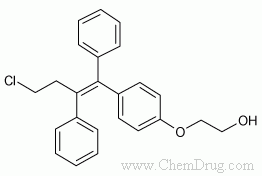
FDA核准Osphena使用在中度至重度的停經後的性交疼痛
The US Food and Drug Administration (FDA) has approved ospemifene (Osphena, Shionogi, Inc) for treating moderate to severe dyspareunia in postmenopausal women, the agencyannounced today.
Dyspareunia is associated with declining levels of estrogen during menopause, which leads to vulvovaginal atrophy, often resulting in pain during sexual intercourse.
Ospemifene is a novel selective estrogen receptor modulator that makes vaginal tissue thicker and less fragile, resulting in a reduction in the amount of pain women experience with sexual intercourse. Ospemifene is taken orally with food once daily.
"Dyspareunia is among the problems most frequently reported by postmenopausal women," Victoria Kusiak, MD, deputy director of the Office of Drug Evaluation III in the FDA's Center for Drug Evaluation and Research, said in a statement. "Osphena provides an additional treatment option for women seeking relief."
The safety and effectiveness of ospemifene for dyspareunia were established in 3 clinical studies of 1889 postmenopausal women with symptoms of vulvar and vaginal atrophy who were randomly assigned to receive ospemifene or a placebo.
After 12 weeks of treatment, results from the first 2 trials showed a statistically significant improvementof dyspareunia in ospemifene-treated women compared with placebo-treated women.
Results from the third study support the drug's long-term safety in treating dyspareunia.
Boxed Warning
Ospemifene is being approved with a boxed warning alerting women and healthcare professionals that the drug, which acts like estrogen on vaginal tissues, has been shown to stimulate the endometrium and cause it to thicken, the FDA said.
"Women should see their health care professional if they experience any unusual bleeding as it may be a sign of endometrial cancer or a condition that can lead to it," the FDA said.
The drug "should be prescribed for the shortest duration consistent with treatment goals and risks for the individual woman," the agency advised.
The boxed warning also states the incidence rates of thrombotic and hemorrhagic strokes (0.72 and 1.45 per 1000 women, respectively) and the incidence rate of deep vein thrombosis (1.45 per 1000 women).
"These rates are considered to represent low risks in contrast to the increased risks of stroke and deep vein thrombosis seen with estrogen-alone therapy," the FDA said.
Common adverse effects of ospemifene reported during clinical trials included hot flushes/flashes, vaginal discharge, muscle spasms, genital discharge, and excessive sweating.





 留言列表
留言列表
 線上藥物查詢
線上藥物查詢 